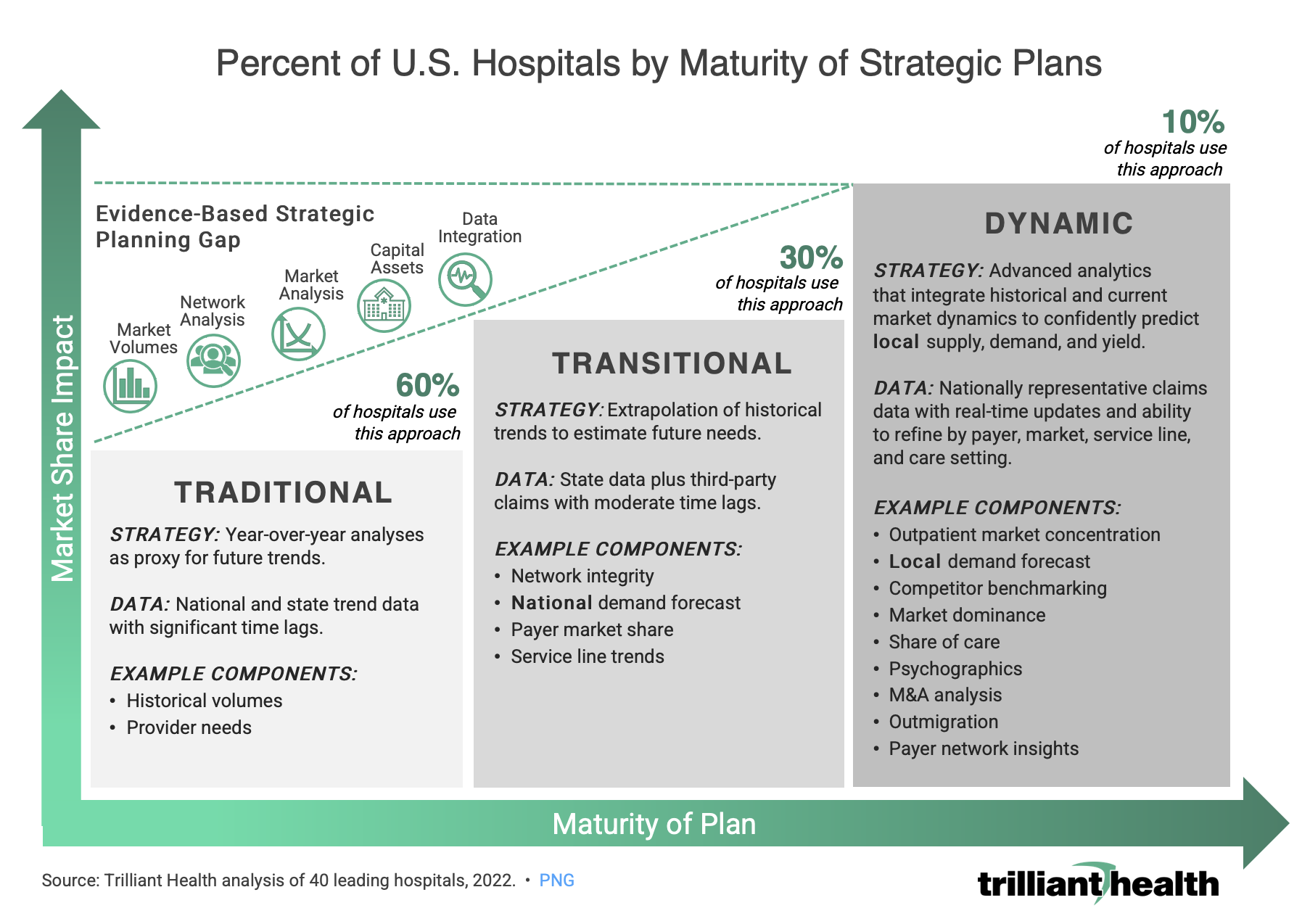Counterpoint
Jon Shap and Alli Oakes, Ph.D. | August 2, 2022The Leading 10% of Hospitals Leverage Dynamic Strategic Planning
Today’s healthcare industry has grown into a complex interconnected web of payers, physician groups, retail clinics, outpatient facilities, large health systems, and biotechnology and pharmaceutical companies, to name a few. The supply side of the health economy has also been influenced by the emergence of large, new market entrants (e.g., Walmart, Amazon) and an explosion of direct-to-consumer, virtual care platforms. As the health economy has evolved, so has the breadth and depth of available data.
Past: Data poor in a predictable environment.
Present: Data rich in an unpredictable environment.
To remain competitive, traditional providers, notably hospitals and health systems, must advance their approach to strategic planning—the process through which leaders define their vision for the future and identify their organization’s objectives and goals—by leveraging this next generation of data to develop a comprehensive, evidence-based approach to decision-making.
Surviving in an Unpredictable Environment
In the past, hospitals were data poor, but the market was predictable. This allowed hospitals to rely on the status quo to remain viable. However, this approach is no longer sufficient. Today, hospitals are operating within a complex and competitive system that creates significant uncertainty. To grow within this kind of environment, hospitals must leverage data from across the entire healthcare market. Yet, we see that many hospitals still rely on the same data that was available to them when their environments were “predictable” and siloed.
Traditionally, strategic plans are developed months or quarters before they are approved. But given the speed at which the health economy is changing, decisions based on “stale” data lead to poor outcomes. Aware of this, leading hospitals and health systems have designed and implemented a dynamic approach to strategic planning, which updates in real-time. Using the latest available data, ensures capital allocation and M&A decisions are accurate and reliable. Importantly, a dynamic strategic plan is not fixed; it is updated throughout the year to account for ongoing market changes and emerging opportunities.
The Value of Dynamic Planning
As strategic plans have evolved so have the datasets on which they are built. Beyond requiring current data, a successful strategic plan needs significant breadth and depth. For example, a traditional analysis might use annual state-level data on disease prevalence and volume to estimate year-over-year trends. However, a dynamic plan leverages nationally representative claims data with the ability to refine by payer, market, service line, and care setting. Importantly, this type of data allows for a hospital or health system to understand what is going on inside and outside of its walls. With complete data serving as the foundation, a dynamic plan is based on a full understanding of the market and can target a comprehensive (and measurable) set of goals and objectives.
Finally, a dynamic strategic plan uses the best-available data to generate and incorporate predictive analytics. Rather than focusing on a singular datapoint, this approach reveals the full range of possible outcomes, based on variable market-specific conditions. Data-driven experimentation reduces uncertainty and allows for evidence-based decision making that maximizes desired outcomes.
Developing a dynamic strategic plan requires both theory and application. In working with many of the leading hospitals and health systems across the country, we have had the chance to study strategic planning in practice and examine the competitive advantage gained by moving from a traditional to a dynamic framework. Across 40 of the nation’s leading hospitals, we examined the data sources and analytics that underlie their strategic planning strategy and examined their market share, revenues, and overall performance. First, we find that only 10% of hospitals meet the criteria for using a dynamic strategic plan (Figure 1). Despite the increasingly competitive healthcare market, most hospitals (60%) still use outdated data and a traditional approach to strategic planning. However, things are changing—approximately 30% of hospitals are in an active state of “transition” and improvement. Most importantly, we find that the 10% of hospitals that use a dynamic strategic plan outpace their peers in year-over-year market share growth by 14.3%.
How To Calculate Your Organization's Maturity Using the Strategic Planning Scorecard:
Download a copy to calculate your score. For each row, determine whether your current strategy most closely aligns with the Traditional (0 points), Transitional (5 points), or Dynamic approach (10 points). Add your score for each row, then see how your total score compares to other hospitals.
Have questions about how to interpret your score?
Connect with us






















.png)

















.png?width=171&height=239&name=2025%20Trends%20Report%20Nav%20(1).png)


